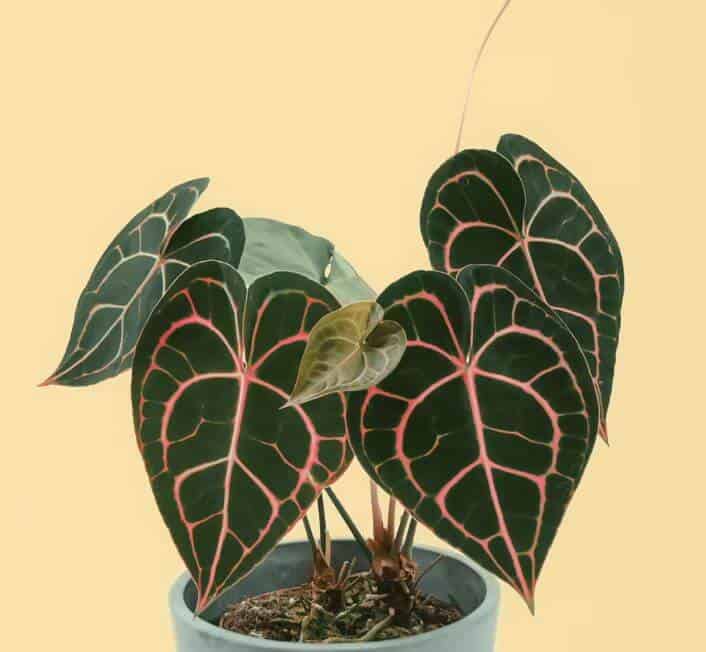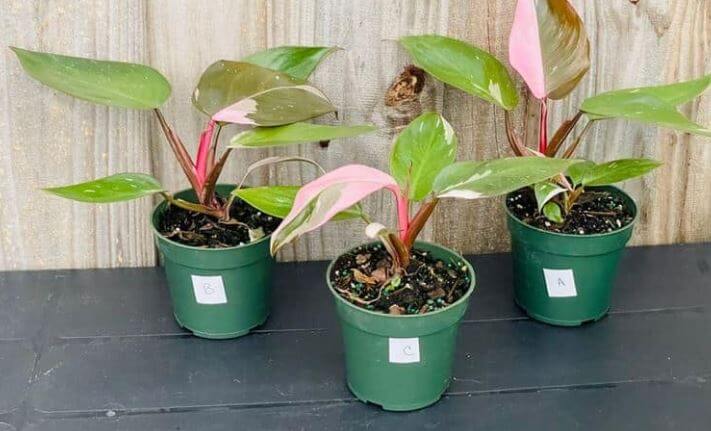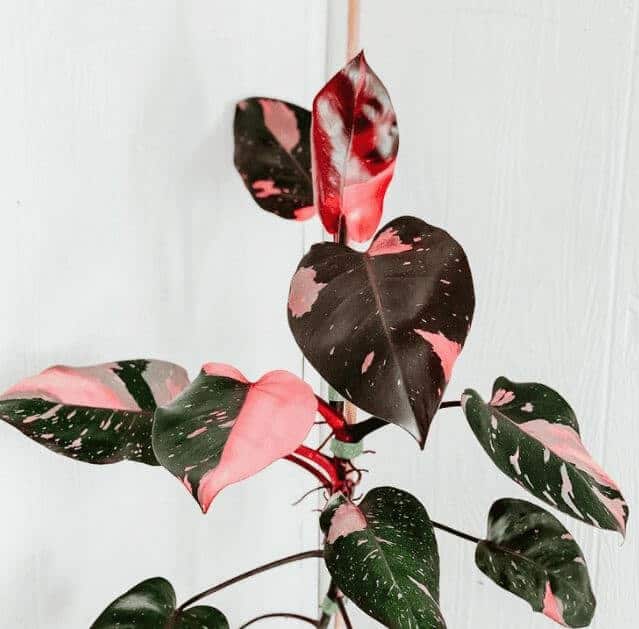Last Updated on September 9, 2023 by a Friendly Gardener
If you’re a serious gardening enthusiast, the pink monstera plant must feature on your list of dream plants. This rare (and therefore, quite expensive) plant is a must-have if you’re looking for an exotic addition to your household that’s going to earn you some serious bragging rights!
It’s a classic case of “small investment, big returns” with the pink monstera plant—with just a little bit of care and effort, you can have this unique, beautiful plant flourishing where planted.
Here’s everything you need to know about the pink monstera plant and caring for it.
A Case of Mistaken Identity

First things first—there is no such thing as a pink monstera plant or pink variegated monsteras! What we call a pink monstera is actually the pink princess philodendron.
This is a common case of mislabeling that many plants of the Monstera genus are subject to, such as the Monstera deliciosa (which is not a philodendron but is referred to as a “split-leaf philodendron”) and the Monstera ginny, which is actually the Rhaphidophora tetrasperma.
The point is—pink monsteras don’t exist! Though philodendrons and monsteras bear quite a resemblance to each other, the experienced eye knows that these are not the same.
However, for the sake of this article, we will be using pink monstera, pink princess philodendron, and pink variegated monstera interchangeably.
Now that we’ve gotten that out of the way, let’s get on with an introduction to the pink princess philodendron and caring for it.
About the Plant

Scientifically known as Philodendron erubescens “pink princess” and colloquially as blushing philodendron, red-leaf philodendron, philodendron pink princess, monstera pink plant, and pink monstera plant, this perennial plant is highly sought after for its gorgeous foliage.
Heart-shaped leaves featuring extremely rare green-and-bubblegum-pink variegation make this plant quite a unique member of the plant kingdom. Unlike the philodendron pink congo, the pink princess’s variegation is completely natural and permanent (the congo’s temporary variegation is a result of injected chemicals).
The pink princess belongs to the Philodendron genus, which, in turn, belongs to the Araceae family. These plants thrive in USDA hardiness zones 10b to 11, where they can be grown as outdoor perennials.
It’s important to note that the pink princess is toxic to pets and humans as it contains strong insoluble oxalates of calcium. If ingested, the plant can cause severe irritation in the mouth, skin, throat, and stomach, accompanied by redness, difficulty swallowing, swelling, and drooling.
Physical Appearance

The pink princess is a vining plant that grows upright, capable of reaching a height of four feet and a width or spread of two feet. As mentioned above, its humongous heart-shaped leaves are this plant’s standout feature, with leaves growing up to five inches wide and nine inches long.
The variegation pattern varies with each individual pink princess—the variegation can be in the form of splotches, streaks, a half-moon shape, or speckles. In some extremely rare cases, the whole leaf can be solid pink.
Additionally, some plants, instead of featuring pink variegation, may feature yellowish or whitish variegation.
Pink princess plants have aerial roots, in addition to red stems and petioles.
Some people tend to confuse the pink princess with the burgundy princess (Philodendron erubescens “Burgundy Princess”), believing that the burgundy shade of the leaves is typical to this variety and present in some of its members.
However, burgundy leaves are a sign that you’re dealing with a burgundy princess, which is a bolder cultivar of the pink princess and not the pink princess itself.
These plants feature pink streaks and flecks on their stems and leaves just as pink princess plants do, but the base color of the leaf leans more towards burgundy than green.
Pink Monstera Plant Care
It is only with proper care that your pink princess will maintain her glorious variegation! Thankfully, pink monstera plant care, as is the case with most members of the Philodendron genus, is pretty simple.
-
Soil
Well-draining soil that is rich in organic content, with the pH ranging between slightly acidic and neutral (5.6 to 7.5), is ideal. Opt for an aroid mix, or even better, make your own by mixing perlite, sphagnum moss, charcoal, worm castings, and bark chips to enrich the soil and improve drainage.
Adequate drainage is highly essential to mitigate any overwatering and prevent the harmful consequences of waterlogging, such as root rot.
-
Humidity
Pink princesses thrive in humidity levels above 50%. If the air isn’t moist enough, there are several ways to introduce humidity to dry air, the most effective being regularly misting the leaves. Alternatively, you could place the plant in humid spots in the house, such as the bathroom, kitchen, or greenhouse.
-
Temperature
Pink princesses require temperatures between 65℉ and 85℉ to realize their maximum growth potential. Though they can tolerate the occasional exposure to slightly lower temperatures, anything below 55℉ can significantly harm the plants. Therefore, don’t place your plant near air-conditioning vents, in areas that experience sudden and drastic temperature changes, in the way of cold drafts, in cold spots, near heating systems or radiators, and in general, any spot or object that emits cold or heat. Additionally, prepare them for winter.
-
Light
Pink princess plants thrive in indirect, bright light. Any direct sunlight shouldn’t be more intense than the early morning sunshine. It’s important to find a balance, as excessive light will cause sunburns, bleaching of the leaves, and browning and drying of the leaves tips and edges, whereas insufficient light will stunt growth. For optimal Monstera growth, consider using dimmable LED grow lights for plants so you can adjust the light intensity anytime necessary.
-
Water
Overwatering can cause root rot to set in quickly, as mentioned earlier. Only water the plant when the top few inches are dry, to prevent overwatering.

Depending on the area, weather, climate, plant size, and other factors, this could be anywhere between once a week (during the growing season, i.e, spring and summer) or once in two weeks (in the dormant season, i.e, winter).
When watering, ensure that you saturate the soil evenly and stop watering as soon as you see water flowing from the container’s drainage holes. Allow 15 minutes for the water to accumulate in the pot tray/saucer and then throw out the water.
-
Fertilizer
These plants enjoy the occasional dose of fertilizer. Use an all-purpose fertilizer once a month in the growing season and avoid fertilizing during the winter. If you’ve just bought your plant, give it four weeks before you apply fertilizer.
-
Repotting
Pink princess plants require repotting every two years when they tend to get root bound. Repotting should be done in the growing season; increase the pot size to the next available size every time you repot and ensure the pot is deep enough for good root growth.
-
Pruning
Pink princesses require pruning only to remove dead, damaged, or diseased leaves and parts. If you want to curb growth or shape the plant, prune it in the growing season, cutting the stem/branch at least half an inch above its node.
-
Propagation
Propagation can be done through stem cuttings in summer or early spring; seeds don’t work for variegated plants.
The Bottom Line
To summarize, pink princesses are easy to care for—all they need are sufficiently humid, warm areas that are well-lit with indirect light, moderate applications of fertilizer, occasional watering, and repotting every couple of years.
Giving your pink princess support or a surface to climb will help it grow even better.
When it comes to pests and diseases, you may need to take measures to prevent scale, spider mites, aphids, and mealybugs, and issues such as root rot and fungal/bacterial infections.
Other symptoms, such as curling, yellowing, browning, or wilting leaves, brown spots, and fungal pests, are all indications of too much or too little light, water, and humidity.

